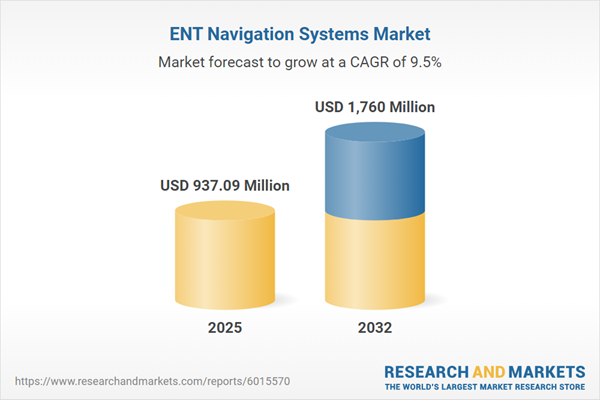Speak directly to the analyst to clarify any post sales queries you may have.
The ENT navigation systems market is transforming as clinical and technological progress accelerates across surgical environments. Senior decision-makers in healthcare benefit from strategic intelligence in this field to inform investments, prioritize patient outcomes, and maintain operational efficiency in an evolving sector.
Market Snapshot: ENT Navigation Systems Market Trends and Growth
In 2024, the ENT navigation systems market registered notable expansion, advancing from USD 856.45 million to a projected USD 937.09 million for the following year. This trajectory positions the market for significant future growth, with a robust CAGR of 9.48% and potential to reach USD 1.76 billion by 2032. Market momentum is fuelled by heightened use of minimally invasive surgery and real-time imaging technologies. Healthcare providers across hospitals and ambulatory centers are increasingly integrating these systems, driven by demands for greater precision, enhanced workflow, and improved patient care pathways. The ongoing shift in care models further underscores the role of ENT navigation systems as essential infrastructure for both clinical advancements and operational excellence.Scope & Segmentation of the ENT Navigation Systems Market
This report delivers an in-depth segmentation of the ENT navigation systems market, supporting strategy development, operational planning, and procurement optimization. The structured segmentation covers a comprehensive range of market dynamics, technology adoptions, and care delivery models:
- Product Type: Includes cart-based and handheld navigation systems, models with reusable or single-use probes, versions using electromagnetic or optical sensors, and systems with advanced planning modules.
- Technology: Details electromagnetic navigation, optical tracking with passive and active solutions, and hybrid systems that combine features for expanded clinical versatility.
- Application: Covers routine rhinology and otology procedures, complex skull base and laryngeal surgeries, supporting a spectrum of clinical applications and patient groups.
- End User: Addresses use in ambulatory surgical centers, outpatient clinics, specialty and tertiary hospitals, spanning both private practices and public healthcare networks.
- Regions Covered: Provides insight into adoption patterns and regional differences across the Americas, Europe, Asia-Pacific, and the Middle East & Africa, adapting to both mature and emerging healthcare systems.
- Major Companies Profiled: Highlights Medtronic plc, Stryker Corporation, Brainlab AG, KARL STORZ SE & Co. KG, Olympus Corporation, Leica Microsystems GmbH, Carl Zeiss Meditec AG, Northern Digital Inc., DePuy Synthes Products, LLC, and Zimmer Biomet Holdings, Inc., representing innovation and reach within the sector.
Key Takeaways for Senior Decision-Makers
- Hybrid navigation systems improve flexibility and accuracy for complex ENT procedures by leveraging combined tracking modalities.
- Next-generation platforms support a broader spectrum of minimally invasive procedures, allowing organizations to meet evolving clinical demands and diverse patient profiles.
- Modular equipment design delivers longevity, facilitates routine maintenance, and supports efficient department-level integration across hospital systems.
- Collaboration among device manufacturers, clinical researchers, and care teams is advancing market adoption through specialized training and knowledge-sharing platforms.
- Continuous progress in probe miniaturization, sensor reliability, and integrated planning tools enables easier adoption for providers and enhances overall patient outcomes.
Tariff Impact on Supply Chain and Cost Structure
Recent tariff adjustments in the United States are impacting the ENT navigation systems sector by increasing costs and introducing new logistical challenges. Duties on sensors and core software components are elevating production expenses and potentially extending delivery times for critical system parts. To mitigate these pressures, manufacturers are increasing local assembly, expanding domestic sourcing, and adapting product lines to avoid tariff-impacted materials. Such efforts aim to reinforce supply chain resilience and lessen procurement risk amid regulatory shifts.
Methodology & Data Sources
This analysis is based on thorough secondary research, validated industry reporting, regulatory data, and in-depth interviews with surgeons, healthcare executives, and technical leaders. Statistical modeling and expert surveys ensure the insights presented are reliable and relevant for ENT navigation systems market stakeholders.
Why This Report Matters
- Presents a structured assessment of the ENT navigation systems market, spotlighting essential trends, key technology drivers, and a competitive landscape tailored for strategic leadership.
- Enables decision-makers to enhance product portfolios, refine purchasing processes, and align resources with changing sector needs.
- Offers tactical guidance on managing tariff impacts, strengthening supply chain integrity, and maintaining compliance with regional regulations.
Conclusion
The ENT navigation systems market remains responsive to changes in technology and regulatory requirements. Strategic, data-driven decisions position organizations for sustainable growth, greater clinical value, and competitive advantage in a dynamic healthcare landscape.
Additional Product Information:
- Purchase of this report includes 1 year online access with quarterly updates.
- This report can be updated on request. Please contact our Customer Experience team using the Ask a Question widget on our website.
Table of Contents
3. Executive Summary
4. Market Overview
7. Cumulative Impact of Artificial Intelligence 2025
Companies Mentioned
The companies profiled in this ENT Navigation Systems market report include:- Medtronic plc
- Stryker Corporation
- Brainlab AG
- KARL STORZ SE & Co. KG
- Olympus Corporation
- Leica Microsystems GmbH
- Carl Zeiss Meditec AG
- Northern Digital Inc.
- DePuy Synthes Products, LLC
- Zimmer Biomet Holdings, Inc.
Table Information
| Report Attribute | Details |
|---|---|
| No. of Pages | 186 |
| Published | October 2025 |
| Forecast Period | 2025 - 2032 |
| Estimated Market Value ( USD | $ 937.09 Million |
| Forecasted Market Value ( USD | $ 1760 Million |
| Compound Annual Growth Rate | 9.4% |
| Regions Covered | Global |
| No. of Companies Mentioned | 11 |









